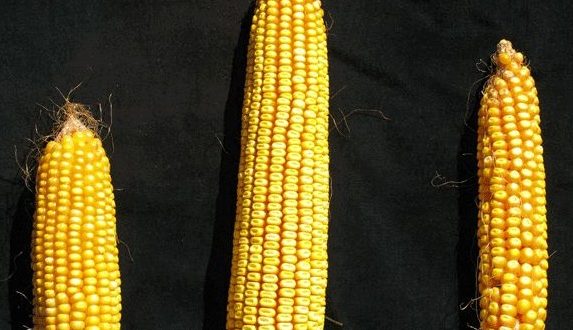Introduction
Heterosis means deviation of the characteristics of offspring from the actual characters of parents.
Heterosis is often called true heterosis or euheterosis. It may be defined as the superiority of an F1 hybrid over both of its parents in terms of yield or some other characters (vigorous, sturdier, taller etc.). Hybrid vigour has been used as a synonym of heterosis.
- Crop breeding to manifest heterosis is called heterosis breeding.
- The term heterosis was 1st used by Shull in 1914.
- It brings out the superiority in F1 individuals but the vigor tends to decrease from F2 generation onwards.

Types of Heterosis
On the basis of source of increased vigour, heterosis is divided into 3 types-
1. Balanced heterosis
It is true heterosis. It arises due to over-dominance gene action i.e heterozygotes over both the corresponding homozygotes.
2. Mutational heterosis
Hybrid vigour may also be created by mutations in organisms which is termed as mutational heterosis. Mutations are seldom beneficial. So the mutational heterosis is of rare importance in comparison to true heterosis.
3. Pseudo-heterosis
Sometimes due to more favourable environment and better cultural practices, the increased growth and vegetative luxuriance are observed in plants which is referred to as pseudo-heterosis. This is a temporary vigour and an accidental occurrence and therefore, can not be utilized in practical plant improvement.
Causes of heterosis
The phenomenon of hybrid vigor can be explained on the basis of
Genetical basis
1. Dominance hypothesis
2. Over-dominance hypothesis
Physiological basis
- Greater initial capital hypothesis
2. Mitochondrial complementation
Biochemical basis
Cytoplasmic basis
Best safe and secure cloud storage with password protection
Get Envato Elements, Prime Video, Hotstar and Netflix For Free
Best Money Earning Website 100$ Day
#1 Top ranking article submission website
Genetical hypothesis
- Dominance hypothesis
This hypothesis was first proposed by Davenport in 1908. It was later expanded by Bruce and by Keeble and Pellew in 1910.
In simplest terms, this hypothesis suggests that at each locus the dominant allele has a favourable effect, while the recessive allele has an unfavourable effect.
In heterozygous state, the deletorious effects of recessive alleles are masked by their dominant alleles.

So heterosis or hybrid vigor results from bringing together the maximum number of dominant favorable genes in the F1 hybrid.
The inbreeds differ genetically from each other and therefore one inbreed may have a certain set of dominant genes and another may have another set of dominant genes.
Hybrids from parents with similar recessive and dominant alleles would show little or no heterosis, while those with different alleles would show heterosis.
For example:


2. Over-dominance hypothesis:
The concept of this hypothesis was given independently by Shull and East (1908).
The basis of this hypothesis is that the heterozygote (Aa) is superior to both the homozygotes (AA or aa) and the amount of heterosis depends on the amount of heterozygosity in the hybrid.
Several names were given like “Super-dominance” by Fisher, “Interaction of alleles at a single locus” by East and over-dominance by Hull.
Convincing support to this hypothesis came from Hull (1945) who observed in maize that, if two inbreds A and B yielded 10 and 12 MT then their F1 yielded more than 22 MT, e.g. 25 to 27 MT.
This could not be explained on the basis of the dominance hypothesis but this could perhaps be better explained on the basis of the over-dominance hypothesis.
Physiological basis
- Greater initial capital hypothesis
Ashby (1930) studied the inbreeds and hybrids of maize and tomato and concluded that the hybrid vigour is due to an increased initial embryo size which he termed as “greater initial capital”.
The validity of this cause however, is disputed by many workers.
East (1936) and Wang (1947) also supported this hypothesis and reported that the increase in endosperm and embryo size is one of the causes of heterosis. Whaley (1950) found that the maize hybrids have more efficient protoplasm and more green and dry weight than the inbreds.
2. Mitochondrial complementation
Sarkissian and Srivastava (1967) studied mitochondrial complementation in five inbreds and their single and double crosses in maize. They reported that mixing mitochondria from parents of heterotic crosses only showed complementation, i.e. heterotic active. Since mitochondria are the chemical power houses of the cells, complementation at that level makes energy transfer in heterotic hybrids more efficient and is hence expressed as heterotic vigour.
Biochemical basis
Robbins (1941) excised root tips from Johannesfeuer and Red Currant varieties of tomato and their hybrids and grew them in solutions supplemented with growth promoting substances, pyridoxine and nicotinamide. It was observed that Johannesfeuer was not able to synthesize pyridoxine and Red Currant nicotinamide and thus responded to their addition. The F1 hybrid was able to grow without pyridoxine and nicotinamide.
Cytoplasmic basis
Cytoplasm is a limpid fluid rich in RNA and mitochondria which is usually transmitted through the female parent to the offspring. A number of evidences are now available to indicate the interaction of nuclear genes and cytoplasm in the production of phenotype of the individual.
Dhawan and Paliwal (1964) crossed Sikkim Primitive and Colorado varieties of maize and reported clear cut reciprocal differences for heterosis.
Importance of heterosis
- Increased yield
Heterosis is generally expressed as an increase in the yields of hybrids. Increased in yield can be measured in terms of grain, seed, fruit, tuber or the whole plant.
2. Increase in size
Heterosis results in more vigorous growth which ultimately leads to healthier and faster growing plants with increase in size than the parents.
3. Better quality
In many cases, hybrids show improved quality. This may or may not be accompanied by higher yields. For example: many hybrids in onion show better keeping quality but not yield.
4. Increased reproductive ability
The hybrids exhibiting heterosis show an increase in fertility or reproductive ability. For example: tuber in potato (Solanum tuberosum), Stem in sugarcane etc.
5. Earlier flowering and maturity
In many cases, hybrids are earlier in flowering and maturity than the parents. Earliness is highly desirable in many cases, particularly in vegetables. Many tomato hybrids are earlier than their parents.
6. Greater adaptability
Hybrids are generally more adapted to environmental changes than inbreeds. In fact, it is one of the physiological explanations offered for heterosis.
7. Faster growth rate
In some cases, hybrids show a faster growth rate than their parents, but that does not always produce larger plant size than the parents.
8. More disease resistant
Some hybrids are known to exhibit a greater resistant to insects or diseases than their parents.
or,
- Quantitative Effect: There is an increase in size and number of quantitative characters like yield, fruit, vegetative parts, etc. due to a greater number of cells resulting from a faster cell division and cell activities.
- Biological Effect: There is an increase in biological efficiency of an organism such as reproductiveness and survival ability exhibited in economic characters.
- Physiological Effect: Effects of the heterosis are also manifested in many physiological traits like adaptability, disease and insect resistance, earliness, etc.
Utilizations and Limitations
The utilization of hybrid vigour on commercial scale requires the production of hybrid seeds in efficient quantity to meet the demand of farmers.
Self pollinated crops:
-
- The hand emasculation and hand pollination are usually practiced which are tedious and costly operations.
- This difficulty is again made more severe where only few seeds are produced with each act of hand-pollination.
- This difficulty of little hybrid seed production with high expenditure practically prohibits the utilization of hybrid vigour in such crops.
-
However, this difficulty has now been overcome by the development of easier and cheaper genetical and chemical methods of emasculation for most of the perfect-flowered plants.
Cross pollinated crops:
-
- It has been utilized spectacularly in these crops.
- However, difficulty is faced in maintaining the hybrid vigour at the same level from generation to generation because it decreases rapidly in F2 and each succeeding generation due to cross pollination and Mendelian segregation.
- The cultivators can not, therefore, be advised to save the seeds from hybrid crop for next year.
- In order to overcome this difficulty, the parental inbreds are maintained, single crosses are produced and distributed to farmers every year freshly.
Vegetatively propagated crops:
-
- Although the difficulty in emasculation and crossing is faced, which in turn is compensation by easier multiplication and maintenance of hybrids.
- In such crops, once obtained desirable hybrid can easily be maintained and multiplied by vegetative propagation until and unless there are disturbances due to somatic mutation.
References & Other Links
- B.D. Singh, Plant breeding: Principles and methods. New Delhi.
- Birchler, J.A., Auger, D.L. and Riddle, N.C. 2003. In search of molecular basis of heterosis.
- Gowen, J.W.1952. Heterosis. U.S.A
- Janossy, A. and Lupton, F.G.H. (eds.) 1976. Heterosis in plant breeding. Elsevier, Amsterdam.
- Pal.B.P. and Sikka, S.M.1956.Exploitation of hybrid vigour in the improvement of crop plants,fruits and vegetables.Indian J.Genet.16Z:95-193.
- Singh, H.B. 1962. Exploitation oh hybrid vigour in vegetables. ICAR series No.33.
- Verma, M.M., Virk, D.S., Chahal, G.S.and Dhillon, B.S. (eds.) 1993. Proc. Symp. Heterosis breeding in crop plants-Theory and Applications. Crop Imp. Soc. Ludhiana, India.
- Allard, R.W. 1960. Principles of plant breeding. John Wiley and Sons Inc, New York.
- Class lectures of Rita Sarha Borna, Assistant professor, University of Dhaka.
Written by
Lipa Mondal, B.S. (Hons), Department of Botany, University of Dhaka
Best safe and secure cloud storage with password protection
Get Envato Elements, Prime Video, Hotstar and Netflix For Free
 Plantlet The Blogging Platform of Department of Botany, University of Dhaka
Plantlet The Blogging Platform of Department of Botany, University of Dhaka




